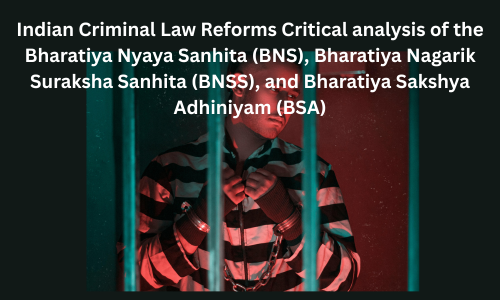Indian Criminal Law Reforms
Critical analysis of the Bharatiya Nyaya Sanhita (BNS), Bharatiya Nagarik Suraksha Sanhita (BNSS), and Bharatiya Sakshya Adhiniyam (BSA)
Introduction
India’s criminal justice system witnessed a historic transformation in 2024 with the enactment of three landmark legislations — the Bharatiya Nyaya Sanhita (BNS), Bharatiya Nagarik Suraksha Sanhita (BNSS), and Bharatiya Sakshya Adhiniyam (BSA). These new laws, which came into effect on July 1, 2024, replaced the colonial-era Indian Penal Code (IPC), Code of Criminal Procedure (CrPC), and Indian Evidence Act of 1872. Their goal was to decolonize the criminal legal framework, modernize justice delivery, and make the system more citizen- and technology-oriented. Collectively, they represent a shift from punishment-centric colonial laws to a more justice-driven model focused on victims’ rights, procedural efficiency, and technological adaptation. However, these ambitious reforms have also invited scrutiny over their practical challenges, human rights concerns, and interpretative ambiguities.[1]
Bharatiya Nyaya Sanhita (BNS): Critical Analysis
The Bharatiya Nyaya Sanhita (BNS) replaces the Indian Penal Code of 1860 and modernizes substantive criminal law by updating outdated definitions, decriminalizing certain acts, and introducing provisions for contemporary crimes such as cybercrimes, organized crime, and financial fraud. The law removes colonial remnants such as sedition, replacing it with an offence that penalizes acts endangering the sovereignty, unity, and integrity of India. It also emphasizes gender inclusivity by recognizing crimes involving transgender persons and introduces community service as an alternative sentence for minor offences. Moreover, the BNS lays down stricter punishments for heinous acts like terrorism, mob lynching, and crimes against women and children. While these provisions align the code with current social realities, critics argue that the broad phrasing of some sections could lead to misuse. For example, replacing sedition with another clause of similar scope may not completely eliminate the dangers of state overreach. Nevertheless, the BNS marks a progressive attempt to infuse clarity, simplicity, and inclusivity into India’s substantive criminal law.[2]
Bharatiya Nagarik Suraksha Sanhita (BNSS): Critical Analysis
The Bharatiya Nagarik Suraksha Sanhita (BNSS) overhauls the procedural framework by replacing the 1973 Criminal Procedure Code. Its primary goal is to ensure time-bound justice through specified deadlines for every stage of criminal proceedings. Key innovations include the formal recognition of e-FIRs, zero FIRs, and online complaint mechanisms that allow victims to report crimes without jurisdictional limitations. Digitization extends to videography of search and seizure operations and digital case management systems, improving accountability and transparency. The BNSS also introduces time-bound plea bargaining, limits undertrial detention, and recognizes the right of victims to receive case updates and be heard before withdrawal of prosecution. These measures directly address India’s chronic issue of delayed trials and prolonged incarceration. However, certain provisions—such as broad investigatory powers and the retention of police custody up to 15 days in a 60-day window—have raised concerns regarding potential misuse. Furthermore, the law centralizes authority in law enforcement agencies, which could challenge the balance between individual liberty and state power. Despite this, the BNSS is commendable for integrating technological advancements and procedural discipline, indicating a systemic effort to make justice efficient, transparent, and accessible.[3]
Bharatiya Sakshya Adhiniyam (BSA): Critical Analysis
The Bharatiya Sakshya Adhiniyam (BSA) replaces the Indian Evidence Act of 1872, modernizing the rules of evidence to accommodate digital and electronic documentation. By granting admissibility to electronic records such as emails, digital signatures, and social media evidence, the Act aligns Indian law with the demands of the digital era. The BSA simplifies archaic terms and restructures sections to streamline evidentiary procedures while maintaining established principles such as relevance, admissibility, and burden of proof. It is particularly significant in increasing the role of forensic and technological inputs in trials, thereby supporting a more scientifically robust justice process. However, critics observe that the BSA largely mirrors its predecessor and could have achieved similar results through targeted amendments. Concerns about data authenticity, privacy violations, and cybersecurity risks also persist, emphasizing the importance of secure systems to handle digital evidence. Thus, while the BSA modernizes evidentiary rules, its success depends heavily on proper implementation and technical infrastructure.[4]
Overall, the BNS, BNSS, and BSA mark a transformative shift in India’s legal landscape by replacing outdated colonial laws with indigenous, reform-oriented frameworks. They embody the principles of decolonization, digitalization, and democratization of justice. However, the reforms’ success will depend on transparent application, adequate institutional training, and vigilant judicial oversight. India’s criminal law reforms of 2024 thus represent both a historic milestone and a continuing challenge—balancing technological advancement and legislative efficiency with the timeless values of justice, fairness, and fundamental rights that define the Indian Constitution.[5]
[1] https://www.lexisnexis.in/blogs/new-criminal-laws-in-india/
[2] https://lawfullegal.in/criminal-law-reforms-2023-in-india-a-critical-analysis-of-the-bharatiya-nyaya-sanhita-bharatiya-nagarik-suraksha-sanhita-and-bharatiya-sakshya-adhiniyam/
[3] https://www.drishtiias.com/daily-updates/daily-news-analysis/new-criminal-laws-come-into-force
[4] https://www.lexisnexis.in/blogs/new-criminal-laws-in-india/
[5] https://prsindia.org/billtrack/the-bharatiya-nagarik-suraksha-sanhita-2023

